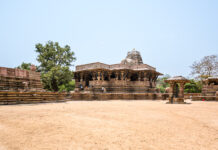Jhansi Fort and the Folklore of the Jumping Point
Orchha and Jhansi may just be 13 kilometres apart, but present-day geopolitics has created a huge divide between them by bringing Orchha under the Madhya Pradesh district of Niwari and making Jhansi a district of Uttar Pradesh. This rift is ironic, as it was Raja Bir Singh Deo, the ruler of Orchha, who built the Jhansi Fort.

Raja Bir Singh Deo built this fort in 1613 CE. In those days, this town was called Balwantnagar. While sitting in Orchha with his friend, the Raja of Jaitpur, he asked if the fort on the distant Bangara hill was visible. Raja of Jaitpur’s one-word response was ‘Jhainsi’ or faintly visible. That short answer changed the name of Balwantnagar to Jhansi.



Jhansi Fort structures
Besides the 16-20 feet thick granite walls, the almost perpendicular ramparts, and its 10 giant gates, the insides of the fort precinct house some notable structures and attractions. These include the Panch Mahal, a Hanging Tower, a Baradari (a pavilion with 12 doors), a Kal Kothari (a black hole dungeon), the famed Jumping Point, a couple of cannons named Kadak Bijli and Bhawani Shankar, a few graves of the brave martyred gunners of Rani Jhansi, a serene garden, a couple of temples, and a few jharokhas (high-ceilinged viewing balconies with windows on three sides).



Panch Mahal was a five-storeyed structure, of which only three exist now. They executed criminals in the Hanging Tower. Raja Gangadhar Rao (husband of Rani Laxmibai or Rani Jhansi) built Baradari for his brother Raghunath Rao, who loved art and architecture. The British later added Kal Kothari to imprison freedom fighters and revolutionaries. Even the jharokhas catered to Raghunath Rao’s love for nature. These jharokhas almost function as well as Jaipur’s famous Hawa Mahal (Palace of Winds) as the gusts of wind give respite even during the harsh summer months in Jhansi.




Though Jhansi Fort was a defence fortification, Raja Gangadhar Rao and Rani Laxmibai were wedded in Ganesh Mandir here. There is also a Shiva temple in the fort.
Click HERE for Jhansi-Orchha Packages

The Folklore of the Jumping Point
Rani Laxmibai (also known as Rani Jhansi), the nerve centre of India’s first war of independence, had attracted all who sought and longed for freedom during the first independence war in 1857 CE. We see her as an epitome of valour even today. She had escaped the British forces by jumping off the fort wall on a horseback. That drop is over 20 feet and the landing is on a steep downward incline. That fateful spot is now marked as the Jumping Point in the fort.



Although Jhansi Fort dates back over 400 years, ASI is now maintaining the structure well. This is a stark departure from my first-visit memories from 22 years ago when the city used the fort as a dump yard. If you want to see the true fulcrum of India’s freedom struggle, visit this fort. Its Rajasthani and Bundela architectures have been a silent witness to the beginnings of the liberation of India.
Pin this origin of India’s Freedom Struggle!





















[…] Image Source – Google | Image By – Travelure […]
Lots of details in here, insightful read. You get to know these things in Light and sound show ?
Thanks, Shreya! I am happy to know you found the post detailed.